2020 浙江杭州师范大学翻译硕士英语考研真题
B. perceived
B. reject
B. resentful
C. obliged
C. cultivated
D. probed
B. take on
C. draw upon
D. turn out
D.
prosecute
C. lose sight of
our main objective.
as an exceptional talent; it is a basic skill that
to the host for his gracious and impressive hospitality.
I. Vocabulary and grammar (30’)
SectionAMultiple choice (20’)
Directions:Beneath each sentence there are four words or phrases marked A, B, C and
D. Choose the answer that best completes the sentence. Mark your answers on the ANSWER
SHEET.
1. Creativity should not be
can be mastered with the right teaching.
A. replaced
2. These guests were
A. contemptuous
3. Whatever we attempt to do, we mustn’t
A. attain
4. With the passage of time, some words are beginning to
A. go about
5. Tourism, particularly ecotourism, helps promote
resources.
A. conservation
6. Despite the
A. radical
7. Life is stressful, so it is always difficult to
A. encounter
8. People who
A. make up for
C. take fancy to
9. The city was
A. subjectively
10. The
world.
A. novel
11. The camps are not usual tent-type camps. They are mostly long-established,
diabetes have to minimize their daily consumption of sugar.
B. crack down on
paralyzed by the transit strike for better wages.
B. imaginably
changes brought about by digital technologies have impacted the whole
changes in this country, many tough issues remain unsolved.
work, school and family.
of wildlife and natural
D. are stricken with
B. distinction
D. prospective
B. reversible
C. rigorous
C. extinction
D. aspiration
D. positively
B. eliminate
C. illuminate
D. prioritize
B. adverse
C. profound
C. virtually
D. mighty
a new sense.
D. insensible
structures, often with strange Islamic names.
D.raw
C. permanent
B. monotonous
B. quantitative
A. historical
12. Among all the changes resulting from the ______ entry of women into the work
force, the transformation that has occurred in the women themselves is not the least
important.
A. massive
13. The manufacturing
the slight decline of an index.
A. version
B. sector
14. Researchers say that
chance of cardiovascular problems.
B. breaking out
A. carrying out
C. quest
cigarettes is necessary to dramatically reduce the
in China is expected to continue to expand in 2019 despite
C. cutting out
D. putting out
D. formidable
C. surplus
D.factor
�
D.
had better
D. as a whole
D. melted
.
.
D. evasion
become California.
D. in the event of
B. erosion
C. illusion
B. in conformity with
B. ambiguous
C. compulsive
B. would rather
C. was to
B. matched
C. mingled
B. at great length
C. all at once
their statement of policy.
underline the wrong word and write the correct one in the blank
, thoughtful and informative.
D. imperative
15. Economic recessions will weaken one’s confidence in the government and threaten
social
A. cohesion
16. The Mexican settlers built cities and missions in what
A. used to
17. Each of us is working hard to get happiness which brings substantial benefits
for society
A. by mere chance
18. Although the colonists ______ to some extent with the native Americans, the
Indians’ influence on American culture and language was not extensive.
A. migrated
19. Most readers believe that this book is
A. intriguing
20. Some of the recent actions of the government are
A. in the interest of
C. in proportion to
SectionB Proofreading and error correction (10’)
The passage contains TEN errors. Each indicated line contains a maximum of ONE error.
In each case, only ONE word is involved. You should proofread the passage and correct
it in the following way:
For a wrong word
provided at the end of the line
mark the position of the missing word with a “Λ” sign and
For a missing word
write the word you believe to be missing in the blank provided at the end of the
line.
For an unnecessary word cross the unnecessary word with a slash “/”and put the
word in the blank provided at the end of the line.
EXAMPLE
WhenΛart museum wants a new exhibit,
an
It never buys things in finished form and hangs (2)
them on the wall. When a natural history museum
wants an exhibition, it must often build it.
Many people are disturbed by the genetic diversify of
cancers--- an inevitable result of random evolution.
Cancer therapies used to be applied fairly random or
Carelessly, but nowadays many believe that effective
therapies need to be specific and tailoring to genetic
faults in each individual’s cancer. Therefore, a personalized(5)
treatment disregards the most fundamental reason
it is difficult to cure cancers once for all: cancer cells
adapt and evolve with response to treatment. Even drugs
that are initially effective often have a progressive
diminishing effect, as the biological systems blocked
of the treatment spontaneously compensateof rerouting
(7)
(8)
(9)
never
(1)
(2)
(3)
(4)
(6)
(1)
(3)
exhibit
�
the cancer cell’s internal wiring, in restoring the cancer’s
ability to spread. To use an analogy, in the absence of
short cuts, evolution takes over: naturally arising mutant
cancer cells that are resistant to the targeted drug rapidly
outgrow their disabled siblings and cancer comes back.
(10)
II. Reading comprehension(40’)
Section A Multiple choice (20’)
Directions: In this section there are two passages followed by multiple choice
questions. Read the passages and then mark your answers on the answer sheet.
Passage A
The language of rights now dominates political debate in the United States. Does
the Government respect the moral and political rights of its citizens? Or does the
Government’s war policy, or its race policy, fly in the face of these rights? Do
the minorities whose rights have been violated have the right to violate the law
in return? Or does the silent majority itself have rights, including the right that
those who break the law be published? It is not surprising that these questions are
now prominent. The concept of rights, and particularly the concept of rights against
the Government, has its most natural use when a political society is divided, and
appeals to co-operation or a common goal are pointless.
The debate does not include the issue of whether citizens have some moral rights
against their Government. It seems accepted on all sides that they do. Conventional
lawyers and politicians take it as a point of pride that our legal system recognizes,
for example, individual rights of free speech, equality, and due process. They base
their claim that our law deserves respect, at least in part, on that fact, for they
would not claim that totalitarian system deserve the same loyalty.
Some philosophers, of cause, reject the idea that citizens have rights apart
from what the law happens to give them. Bentham thought that the idea of moral rights
was “nonsense on stilts”. But that view has never been part of our orthodox
political theory, and politicians of both parties appeal to the rights of the people
to justify a great part of what they want to do. I shall not be concerned, in this
essay, to defend the thesis that citizens have moral rights against their governments;
I want instead to explore the implications of that thesis for those, including the
present United States Government, who profess to accept it.
It is much in dispute, of cause, what particular rights citizens have. Does the
acknowledged right to free speech, for example, include the right to participate
in nuisance demonstrations? In practice, the Government will have the last word on
what an individual’s rights are, because its police will do what the officials and
courts say. But that does not mean that the Government’s view is necessarily the
correct view, anyone who thinks it does must believe that men and women have such
moral rights as Government chooses to grant, which means they have no moral rights
at all.
All this is sometimes obscured in the United States by the constitutional system.
The American Constitution provides a set of individual legal rights in the First
�
Amendment, and in due process, equal protection, and similar clauses. Under present
legal practice the Supreme Court has the power to declare an act of Congress or of
a state legislature void if the Court finds that the act offends these provisions.
This practice has had some commentators to suppose that individual moral rights
are
fully protected by this system, but that is hardly so, nor could it be so.
In the United States nowadays__________.
politicians are discussing about the right language.
politicians are debating about what is right and what is wrong.
language is the most important theme in the political debate.
we can hear lots of talks about rights.
It is only natural that questions about citizens’ rights are now prominent
the minorities are violating the law.
the political society in the USA is divided.
the silent majority wants to punish those who have violated the law.
people are looking for a common goal.
Which of the following statements is not true?
It is generally agreed that citizens should have some moral rights.
It is a moral right of the citizens to respect the legal system.
Citizens’ moral rights include free speech, equality and due process.
The legal system deserves respect because it recognizes citizens’ moral rights.
In this essay the author will not be concerned to defend the thesis that citizens
1.
A.
B.
C.
D.
2.
because__________
A.
B.
C.
D.
3.
A.
B.
C.
D.
4.
have moral rights against their government because__________
A.
B.
rights that the law gives them.
C.
D.
5.
A.
government does not.
B.
not do that.
C.
practice.
D.
citizens’ moral rights.
this thesis has never bee put into question in the mainstream political theory.
he shares the view of those philosophers who think that citizens only have the
this thesis has appeal to politicians of both parties.
the United States government professes to accept this thesis.
The author believes that__________
the United States Constitution protects citizens’ moral rights but the
the Supreme Court has the power to protect citizens’ moral rights but it does
Citizens’ moral rights could not be fully protected by the present legal
the United States Constitution does not have provisions that fully protect
Passage B
What do you do when everyone hates you? That is the problem faced by America’s
pharmaceutical industry. Despite its successes in treating disease and extending
longevity, soaring health-care costs and bumper profits mean that big drug firms
are widely viewed as exploitative, and regarded almost as unfavorably as tobacco
�
and oil firms (see chart). Last week, at a conference organized by The Economist
in Philadelphia, the drug industry was offered some advice from an unlikely source:
a tobacco firm. Steven Parrish of Altria, the conglomerate that includes Philip
Morris, gave his perspective on how an industry can improve its tarnished public
image.
Comparing the tobacco and pharmaceutical industries might seem absurd, or even
offensive.
“Their products kill people. Our products save people's lives,” says Alan Holmer,
the head of the Pharmaceutical Research and Manufacturers of America, an industry
association. Yet the drug giants currently face an unprecedented onslaught of
class-action lawsuits and public scrutiny; industry bosses are being grilled by
lawmakers asking who knew what and when. It is all reminiscent of what happened to
the tobacco industry in 1994.
Mr. Parrish advised drug firms to abandon their bunker mentality and engage with
their critics. Rather than arguing about the past, he said, it is better to move
on, and give people something new to think about. (Philip Morris now acknowledges,
for example, that cigarettes are addictive and deadly, and is trying to develop less
harmful products.) Not everyone is open to persuasion, so focus on those who are,
he said. But changing opinions takes time and demands deeds as well as words: “This
is not about spin, this is about change.”
The pharmaceutical industry is pursuing a range of initiatives to mollify its critics,
Mr. Holmer noted in his own speech. But Mr. Parrish suggested that speaking with
one voice through a trade association might be counter-productive, since it can give
the impression that the industry is a monolithic cartel. And too much advertising,
he said, can actually antagonize people further.
The audience was generally receptive, claims Mr. Parrish. This is not the first time
he has offered his thoughts on dealing with implacable critics. At a conference at
the University of Michigan last year, he offered America’s State Department advice
on improving America’s image in the Middle East. So does his prescription work?
There has been a positive shift in attitudes towards tobacco firms, if only a small
one. But at least, for once, a tobacco firm is peddling a cure, rather than a disease.
Because it, like tobacco and oil firms, does harm to people‘s health and
Because it fails to cure disease and make people live longer.
Because the prices of its products are too high and its profit margin is too
1. Why is America’s pharmaceutical industry so unpopular?
A.
environment.
B.
C.
wide.
D.
2. Alan Holmer is quoted to illustrate that __________
A.
ridiculous, or even insulting.
B.
C.
Because it exploits its employees.
the comparison between tobacco and pharmaceutical industries might seem
the pharmaceutical industries agree that they are similar to tobacco industry.
tobacco products do more harm to people than pharmaceutical products.
�
placate
enrage
fight
relieve
pharmaceutical industries are currently facing lots of problems.
To acknowledge the problems and try to do something to improve their images.
Not to react to the public in one voice through the drug association.
Not to care about the past.
To try to spend time and energy to persuade the majority of the audience who
D.
3. According to the text, Mr. Parrish gives the following suggestions to drug firms
except__________
A.
B.
C.
D.
are open to persuasion.
4. The word “mollify” (Line 1, Paragraph 4) might mean?
A.
B.
C.
D.
5. What does the author imply by saying “This is not the first time he has offered
his
thoughts on dealing with implacable critics.”?
A.
several times.
B.
C.
D.
Section B Answering questions(20’)
Directions: Read the following two passages and then answer IN COMPLETE SENTENCES
the questions which follow each passage. Use only information from the passage you
have just read and write your answers on the answer sheet.
Questions 1-3
Mr. Parrish has offered his advice to other on dealing with tough critics for
Mr. Parrish has dealt successfully with other critics himself.
Mr. Parrish has given sound advice to drug firms.
Mr. Parrish has been of help to others on critical moments.
New tools offer new opportunities, but what are the risks and who benefits?
Human intervention for the improvement of crops, trees, livestock and fish is
nothing new. For millennia, humans have bred, crossed and selected those varieties,
ecotypes and breeds that were more productive, better adapted or particularly
useful.
Conventional breeding practices can now be complemented by a number of new and
powerful techniques. Some of these allow, for example, the propagation of plant
material in glass tubes to keep it free of diseases, and the production of more
sensitive and specific reagents for diagnosing diseases in plants, livestock and
fish through tissue and cell culture. Others, often referred to as molecular methods,
enable scientists to see the layout of the entire genome of any organism and to select
plants and animals with preferred characteristics by “reading” at the molecular
level, saving precious time and resources.
Modern biotechnology also includes an array of tools for introducing or deleting
a particular gene or genes to produce plants, animals and micro-organisms with novel
traits. This kind of genetic manipulation is called “genetic engineering” and the
product is a genetically modified organism, or GMO. Both traditional and modern
biotechnologies result in plants, animals and micro-organisms with combinations of
�
genes that would not have come about without human intervention. It has to be
emphasized, however, that biotechnology includes a range of techniques and products,
and GMOs are but one of them.
“With the increasingly limited amount of new land available to agriculture,
modern biotechnologies could complement and improve the efficiency of traditional
selection and breeding techniques to enhance agricultural productivity,” says
Mahmoud Solh, Director of FAO’s Division of Plant Production and Protection.
A plant or an animal resistant to a particular disease can be produced through
a “traditional” breeding programme, that is, through crosses with resistant
relative, selection and backcrossing again, or by the introduction of a gene that
confers the resistance through genetic engineering. While the products of both
approaches will be disease resistant, only the second one is a GMO. What is new is
the ability of scientists to unravel the genome to look at the genes of an organism,
and then make use of that information to change the organism, and even transfer genes
to another organism very distant in the evolutionary scale. And that is where the
controversy comes in.
“FAO recognizes that genetic engineering has the potential to help increase
production and productivity in agriculture, forestry and fisheries,” says FAO’s
Statement on Biotechnology. “It could lead to higher yields on marginal lands in
countries that today cannot grow enough food to feed their people.” But, it adds,
FAO “is also aware of the concern about the potential risks posed by certain aspects
of biotechnology. These risks fall into two basic categories: the effects on human
and animal health and the environmental consequences.”
These new tools offer new opportunities for solving problems where traditional
techniques have failed. Genetically modified products are usually developed and used
for large-scale commercial interests, and with a few exceptions, small-scale farmers
have so far not benefited from the technology.
The articles in this focus are intended to provide background information on
genetic engineering in agriculture for the non-specialist--what it is, how it is
being used, how it might be used in the future and possible benefits and risks. If
you are new to the subject, you might find it easiest to read the pages in the order
shown in the column on the right. Those who would like to pursue the subject further
may wish to visit.
1.
2.
3.
According to the passage, what is called “genetic engineering”?
What are the potential benefits and risks of genetic engineering in agriculture?
Why are small-scale farmers unlikely to benefit from biotechnology?
Questions 4-5
According to the latest figures, the majority of the world’s population is now
bilingual or multilingual, having grown up speaking two or more languages. In the
past, such children were considered to be at a disadvantage compared with their
monolingual peers. Over the past few decades, however, technological advances have
allowed researchers to look more deeply at how bilingualism interacts with and
changes the cognitive and neurological systems, thereby identifying several clear
�
benefits of being bilingual.
Research shows that when a bilingual person uses one language, the other is
active at the same time. When we hear a word, we don’t hear the entire word all
at once: the sounds arrive in sequential order. Long before the word is finished,
the brain’s language system begins to guess what that word might be. If you hear
‘can’, you will likely activate words like ‘candy’ and ‘candle’ as well, at
least during the earlier stages of word recognition. For bilingual people, this
activation is not limited to a single language; auditory input activates
corresponding words regardless of the language to which they belong. Some of the
most compelling evidence for this phenomenon, called ‘language co-activation’,
comes from studying eye movements. A Russian-English bilingual asked to ‘pick up
a marker’ from a set of objects would look more at a stamp than someone who doesn’t
Know Russian, because the Russian word for ‘stamp’, marka, sounds like the English
word he or she heard, ‘marker’. In cases like this, language co-activation occurs
because what the listener hears could map onto words in either language.
Having to deal with this persistent linguistic competition can result in
difficulties, however. For instance, knowing more than one language can cause
speakers to name picture more slowly, and can increase ‘tip-of-the-tongue states’,
when you can almost, but not quite, bring a word to mind. As a result, the constant
juggling of two language creates a need to control how much a person accesses a
language at any given time. For this reason, bilingual people often perform better
on tasks that require conflict management. In classic Stroop Task, people see a word
and are asked to name the colour of the word’s font. When the colour and the word
match (i.e., the word ‘red’ printed in red), people correctly name the colour more
quickly than when the colour and the word don’t match (i.e., the word ‘red’ printed
in blue). This occurs because the word itself (‘red’) and its font colour (blue)
conflict. Bilingual people often excel at tasks such as this, which tap into the
ability to ignore competing perceptual information and focus on the relevant aspects
of the input. Bilinguals are also better at switching between two tasks; for example,
when bilinguals have to switch from categorizing objects by colour (red or green)
to categorizing them by shape (circle or triangle), they do so more quickly than
monolingual people, reflecting better cognitive control when having to make rapid
changes of strategy.
It also seems that the neurological roots of the bilingual advantage extend to
brain areas more traditionally associated with sensory processing. When monolingual
and bilingual adolescents listen to simple speech sounds without any intervening
background noise, they show highly similar brain stem responses. When researchers
play the same sound to both groups in the presence of background noise, however,
the bilingual listeners’ neural response is considerably larger, reflecting better
encoding of the sound’s fundamental frequency, a feature of sound closely related
to pitch perception.
Such improvements in cognitive and sensory processing may help a bilingual
person to process information in the environment, and help explain why bilingual
adults acquire a third language better than monolingual adults master a second
�
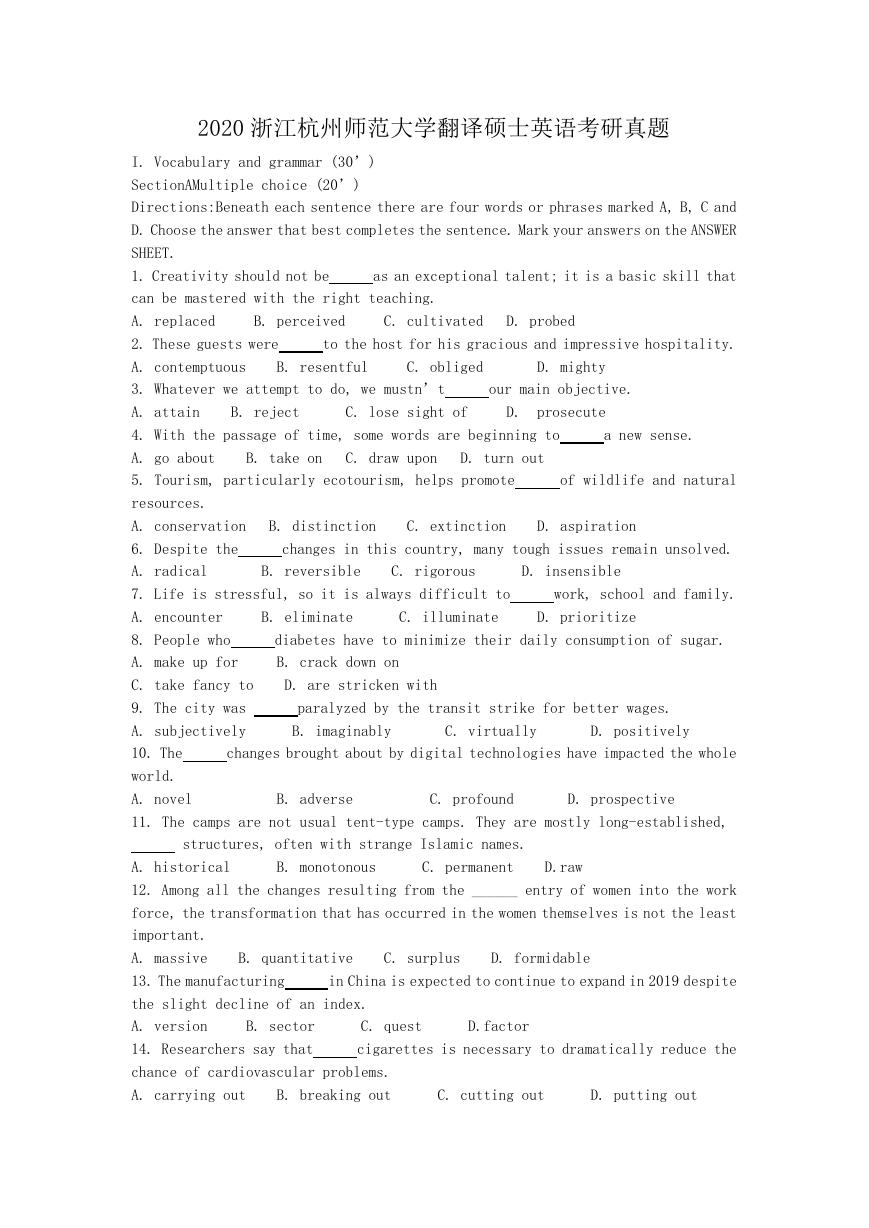

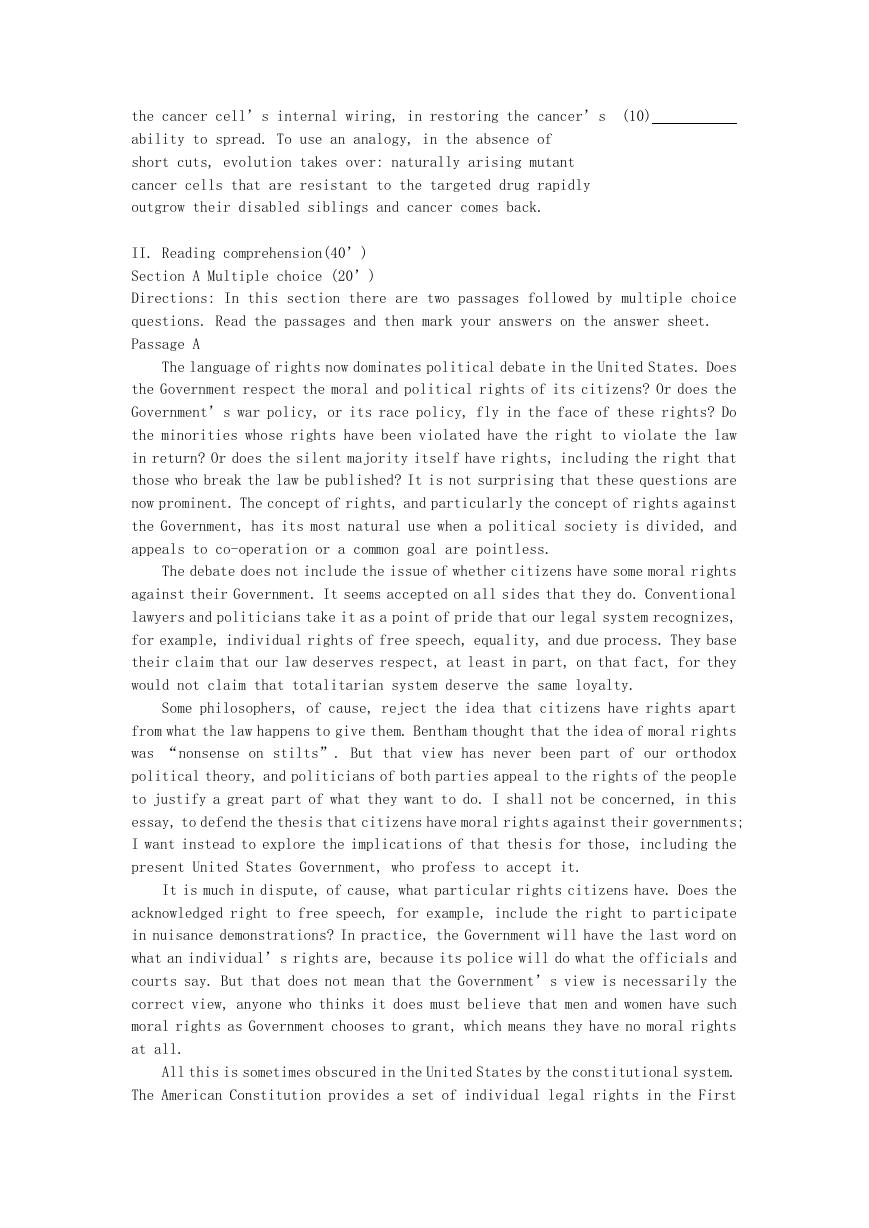
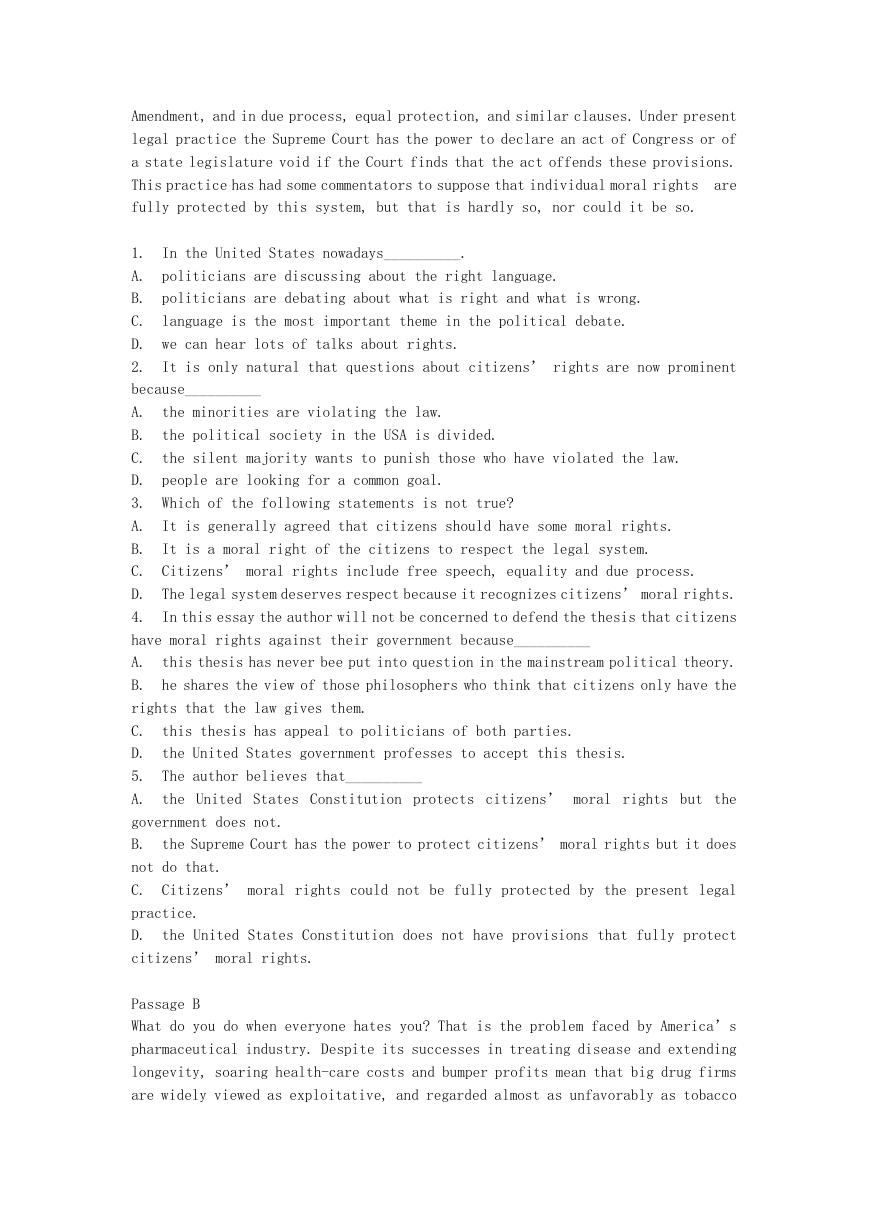
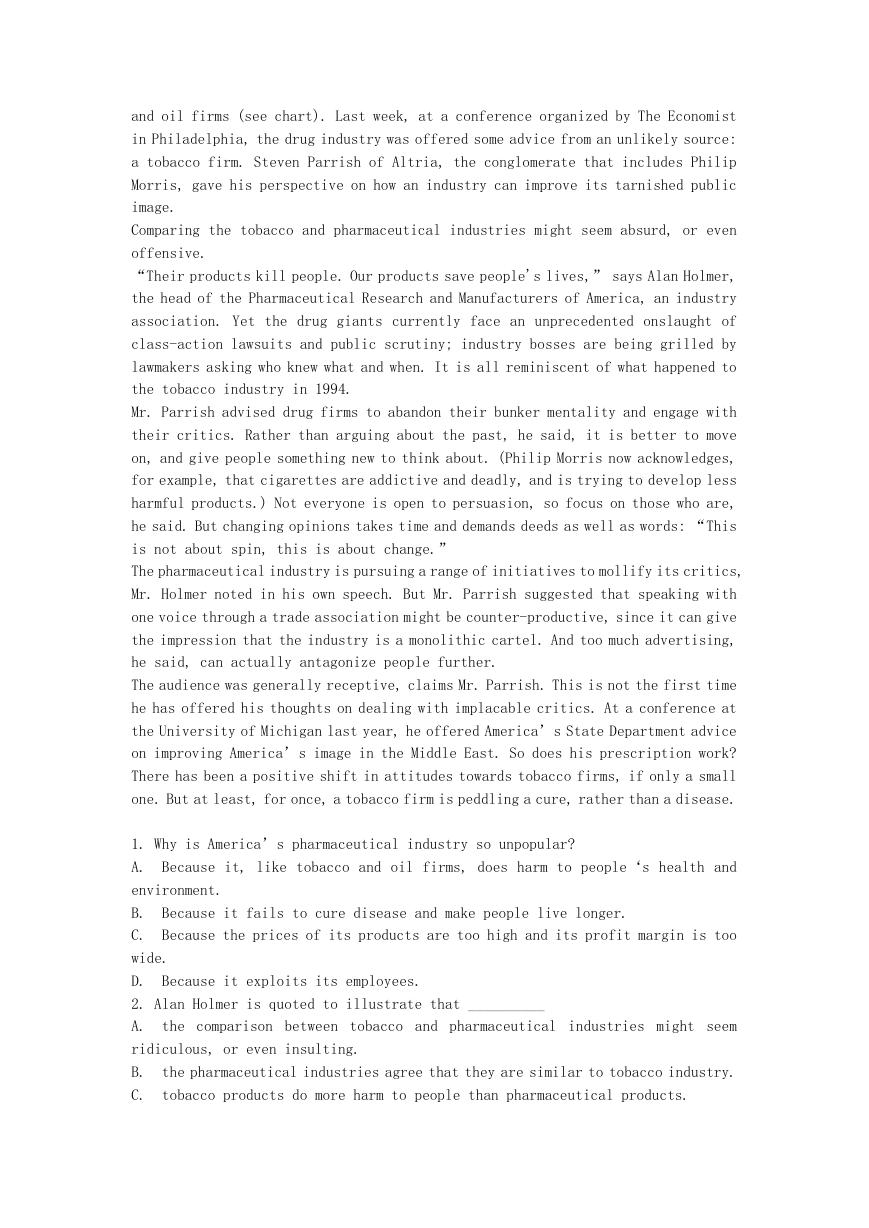
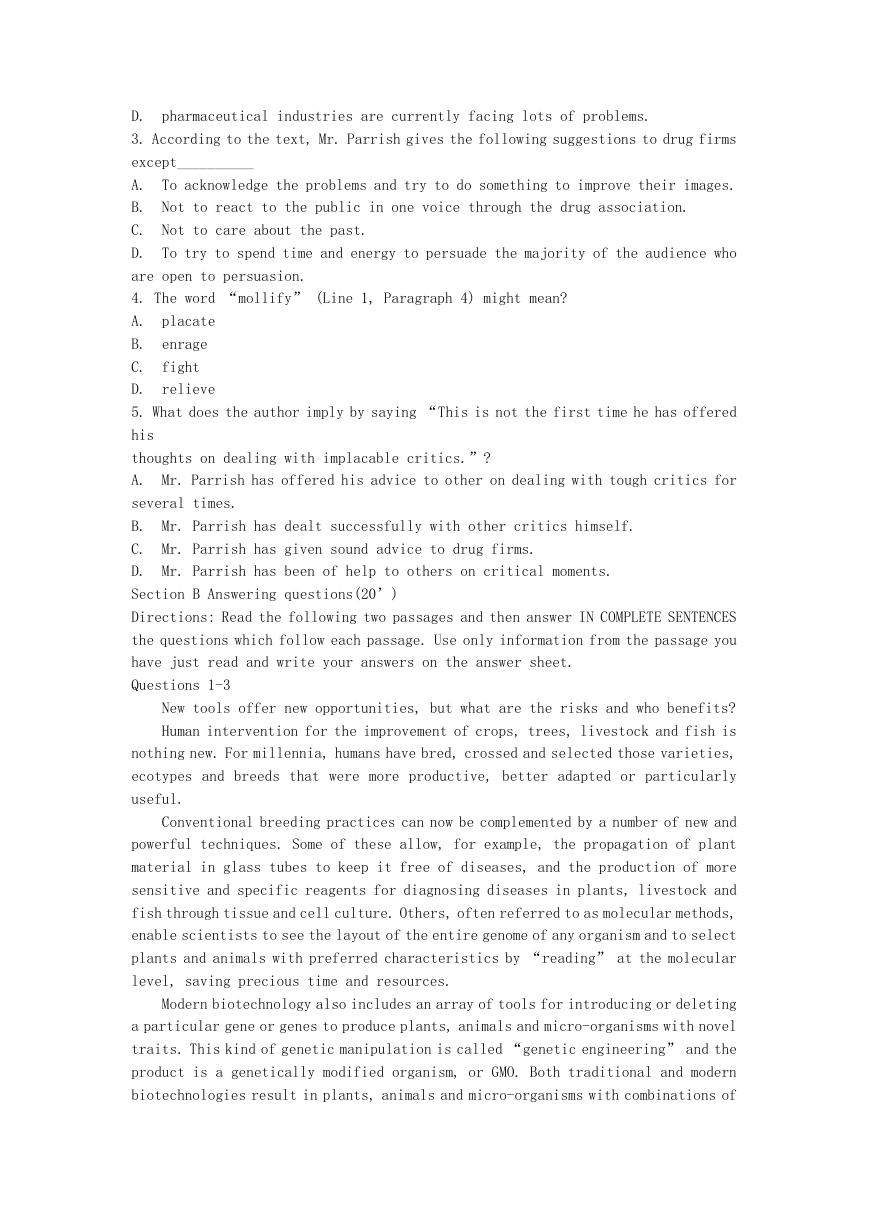
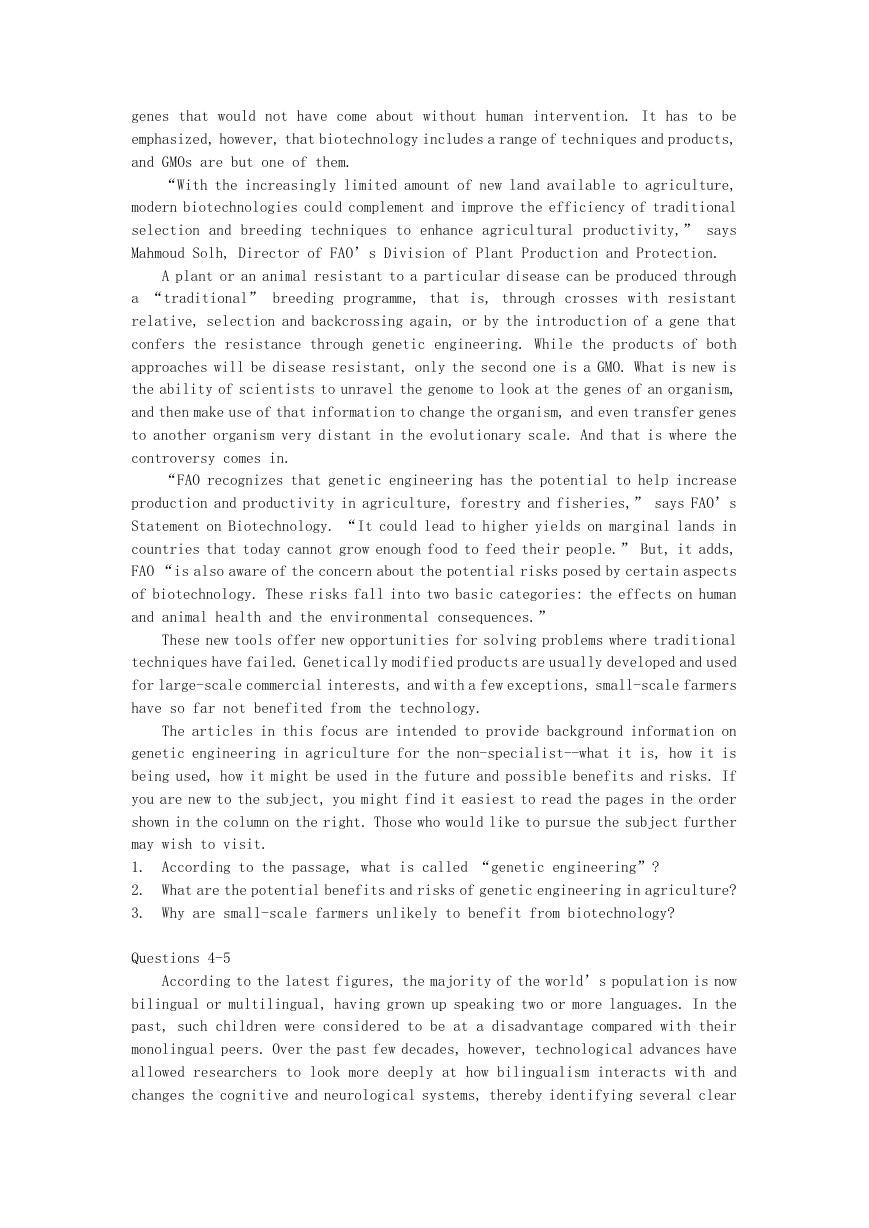
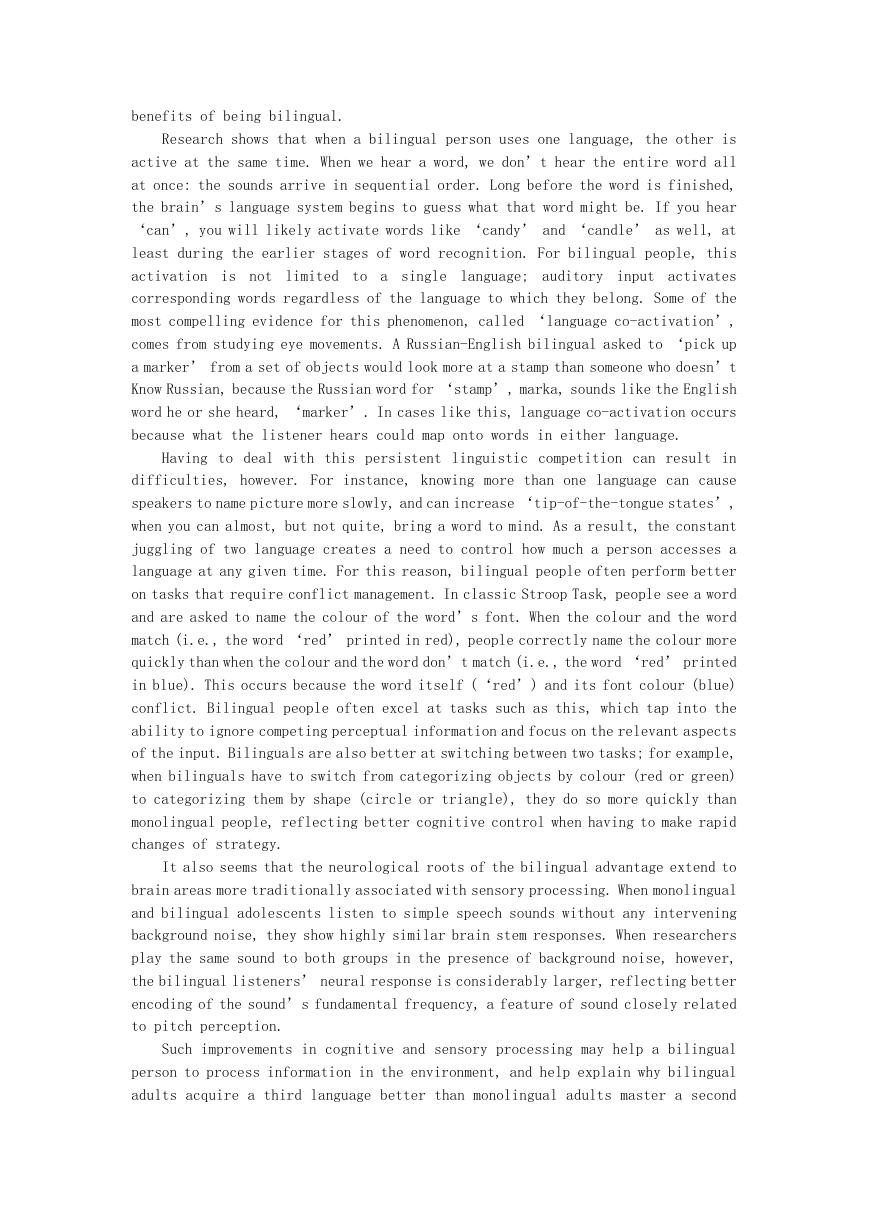








 2023年江西萍乡中考道德与法治真题及答案.doc
2023年江西萍乡中考道德与法治真题及答案.doc 2012年重庆南川中考生物真题及答案.doc
2012年重庆南川中考生物真题及答案.doc 2013年江西师范大学地理学综合及文艺理论基础考研真题.doc
2013年江西师范大学地理学综合及文艺理论基础考研真题.doc 2020年四川甘孜小升初语文真题及答案I卷.doc
2020年四川甘孜小升初语文真题及答案I卷.doc 2020年注册岩土工程师专业基础考试真题及答案.doc
2020年注册岩土工程师专业基础考试真题及答案.doc 2023-2024学年福建省厦门市九年级上学期数学月考试题及答案.doc
2023-2024学年福建省厦门市九年级上学期数学月考试题及答案.doc 2021-2022学年辽宁省沈阳市大东区九年级上学期语文期末试题及答案.doc
2021-2022学年辽宁省沈阳市大东区九年级上学期语文期末试题及答案.doc 2022-2023学年北京东城区初三第一学期物理期末试卷及答案.doc
2022-2023学年北京东城区初三第一学期物理期末试卷及答案.doc 2018上半年江西教师资格初中地理学科知识与教学能力真题及答案.doc
2018上半年江西教师资格初中地理学科知识与教学能力真题及答案.doc 2012年河北国家公务员申论考试真题及答案-省级.doc
2012年河北国家公务员申论考试真题及答案-省级.doc 2020-2021学年江苏省扬州市江都区邵樊片九年级上学期数学第一次质量检测试题及答案.doc
2020-2021学年江苏省扬州市江都区邵樊片九年级上学期数学第一次质量检测试题及答案.doc 2022下半年黑龙江教师资格证中学综合素质真题及答案.doc
2022下半年黑龙江教师资格证中学综合素质真题及答案.doc